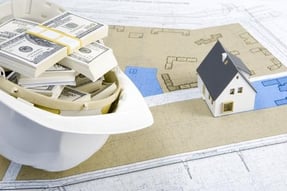Getting Your Remodeling Business Ready to Produce More Work
 Growth in consumer spending on remodeling during 2018, and beyond, is expected to skyrocket. This means that remodelers will have the opportunity to grow their businesses, and if done well; will make a lot of money. But is your business ready for the work? If you are already working too hard for too many hours will increasing volume just end up with you in divorce court and or on blood pressure medicine? Below I offer a vision, and some suggestions, for what you can do to be ready. If you already allowed yourself to get in too deep, then perhaps my suggestions can help you create a plan to get things running better than you had ever imagined.
Growth in consumer spending on remodeling during 2018, and beyond, is expected to skyrocket. This means that remodelers will have the opportunity to grow their businesses, and if done well; will make a lot of money. But is your business ready for the work? If you are already working too hard for too many hours will increasing volume just end up with you in divorce court and or on blood pressure medicine? Below I offer a vision, and some suggestions, for what you can do to be ready. If you already allowed yourself to get in too deep, then perhaps my suggestions can help you create a plan to get things running better than you had ever imagined.
It all starts with estimating.
Estimating might as well be the center of the universe for remodeling contractors. Using a defined process and key information, your production team can conquer that universe. If you grow your business without an advanced estimating system you risk dropping into a financial black hole. Your estimating should not only help provide a profitable selling price, it should also create, document, and organize the information your production team needs to build independently, without constantly bothering you or your salespeople. Done well, it should also help you predict your cash flow needs, and therefore your payment schedules. This way every job finances itself using your clients' money to pay bills on time, not yours. Successful estimating will also help your production team identify and schedule all the resources needed to complete the project weeks, or even months, before they are actually needed at the job site.
A real estimating system includes job costing.
First, an estimate is not  what you give to a prospective client. That is called a price. The estimate is really the contractor's best guess on what the project will cost their business to complete before overhead and profit are added. That's right, it’s just a guess. To continuously improve the accuracy of that guess, particularly as your business is exposed to new products and construction methods, or brings on new untested employees, job costing will be the only way to reduce the risks of estimating. Imagine going six months or a whole year before realizing you were using inaccurate information. Imagine the benefits of offering profit sharing if your team brings jobs in on budget. But, what if your budgets are never adequate and there are no profits to share, and when your employees ask why you can't tell them?
what you give to a prospective client. That is called a price. The estimate is really the contractor's best guess on what the project will cost their business to complete before overhead and profit are added. That's right, it’s just a guess. To continuously improve the accuracy of that guess, particularly as your business is exposed to new products and construction methods, or brings on new untested employees, job costing will be the only way to reduce the risks of estimating. Imagine going six months or a whole year before realizing you were using inaccurate information. Imagine the benefits of offering profit sharing if your team brings jobs in on budget. But, what if your budgets are never adequate and there are no profits to share, and when your employees ask why you can't tell them?
This all requires a well set up financial system.
 Even if you are a good estimator and you never miss any of the sticks and bricks, if you do not know which labor rate and markup to use you may be buying jobs instead of selling them. Without a well thought out list of estimating and matching time card work categories (sometimes referred to as phases), you will never know how well your team did compared to your estimated labor assumptions in specific areas. Also, without the right time card categories, how will you know and or confirm how many non-billable hours of pay you will need to add to, and cover, inside the burden labor rate you assume and charge for their billable hours?
Even if you are a good estimator and you never miss any of the sticks and bricks, if you do not know which labor rate and markup to use you may be buying jobs instead of selling them. Without a well thought out list of estimating and matching time card work categories (sometimes referred to as phases), you will never know how well your team did compared to your estimated labor assumptions in specific areas. Also, without the right time card categories, how will you know and or confirm how many non-billable hours of pay you will need to add to, and cover, inside the burden labor rate you assume and charge for their billable hours?
There are plenty of things to work on as you grow a remodeling business. However, if you don't get the estimating of your jobs right growing your business will just help you lose money faster.



 Below is a list of considerations regarding how you can do business as a remodeler. The list starts with an initial inquiry from a prospect and is broken out by typical steps of the process up through wrapping up a remodeling project. There are lots of things to consider related to each step depending on the type of work you do, who your target customer is and how you do or will decide to do business. Keep in mind your decisions in each step can or will affect other steps. Please assume it to be a partial list. I hope you find the list to be a helpful way for you to get started thinking through how you do business.
Below is a list of considerations regarding how you can do business as a remodeler. The list starts with an initial inquiry from a prospect and is broken out by typical steps of the process up through wrapping up a remodeling project. There are lots of things to consider related to each step depending on the type of work you do, who your target customer is and how you do or will decide to do business. Keep in mind your decisions in each step can or will affect other steps. Please assume it to be a partial list. I hope you find the list to be a helpful way for you to get started thinking through how you do business.  What does the business need to know about the prospect and their project?
What does the business need to know about the prospect and their project? Will you expect all product selections be made before offering a fixed price?
Will you expect all product selections be made before offering a fixed price? When does the job end and the warranty begin? (What does your contract say about this now?)
When does the job end and the warranty begin? (What does your contract say about this now?) My dad asked me if I would write an article for him about the value of being raised as a contractor’s daughter, and how that might differ from other people’s experiences. I can’t actually imagine what it might be like to not be a contractor’s daughter. My childhood was filled with the smell of sawdust flying through the air, and classic rock crackling in from a dusty radio. Many of my earliest memories are of playing with my sister at the office around proudly branded displays of windows and shutters, and pretending to be mermaids in the basement storage. It shaped who I am.
My dad asked me if I would write an article for him about the value of being raised as a contractor’s daughter, and how that might differ from other people’s experiences. I can’t actually imagine what it might be like to not be a contractor’s daughter. My childhood was filled with the smell of sawdust flying through the air, and classic rock crackling in from a dusty radio. Many of my earliest memories are of playing with my sister at the office around proudly branded displays of windows and shutters, and pretending to be mermaids in the basement storage. It shaped who I am. More than once I watched my father and his brothers build a house or barn. I cannot begin to describe to you the lingering feeling of awe which this type of undertaking inspires. With synchronicity honed their whole lives, they would take a wooded hill and a stack of reclaimed lumber, and create monoliths to my child’s eyes.
More than once I watched my father and his brothers build a house or barn. I cannot begin to describe to you the lingering feeling of awe which this type of undertaking inspires. With synchronicity honed their whole lives, they would take a wooded hill and a stack of reclaimed lumber, and create monoliths to my child’s eyes. As the dust settles on my wild adolescence I have carried with me a foundation of values on which to build my adult life. Now it seems I just can’t shake the need to buy my own house and some dirt to sit it on. I find that less and less of my down time is spent scrolling Facebook, and more and more is spent Googling the cost of putting in a septic system and what contributes to real estate values. As I drive down the street I find myself judging the quality of people’s roofs and cringing at water damage where proper gutter installation is begging to be.
As the dust settles on my wild adolescence I have carried with me a foundation of values on which to build my adult life. Now it seems I just can’t shake the need to buy my own house and some dirt to sit it on. I find that less and less of my down time is spent scrolling Facebook, and more and more is spent Googling the cost of putting in a septic system and what contributes to real estate values. As I drive down the street I find myself judging the quality of people’s roofs and cringing at water damage where proper gutter installation is begging to be.
 The importance to your brand
The importance to your brand Managing one way of doing business is hard enough. Do you really want to manage an unlimited number of business methods?
Managing one way of doing business is hard enough. Do you really want to manage an unlimited number of business methods?
 Keep Particles out of Your Lungs
Keep Particles out of Your Lungs Protect Your Eyes
Protect Your Eyes

 Before heading to work each day, check the treads and condition of your car or truck’s tires to make sure they're safe to drive on, and then conduct the same practice before heading home at the end of the day. When it's time to replace the tires on your truck or SUV, consider an all-terrain variety like the Nitto Ridge Grappler from an online retailer like TireBuyer.com.
Before heading to work each day, check the treads and condition of your car or truck’s tires to make sure they're safe to drive on, and then conduct the same practice before heading home at the end of the day. When it's time to replace the tires on your truck or SUV, consider an all-terrain variety like the Nitto Ridge Grappler from an online retailer like TireBuyer.com. In addition to maintaining the outside of your vehicle, what you keep inside it should also prepare you for safely spending time at a job site. Keep your personal safety equipment in your vehicle at all times and double check you have everything before leaving home in the morning.
In addition to maintaining the outside of your vehicle, what you keep inside it should also prepare you for safely spending time at a job site. Keep your personal safety equipment in your vehicle at all times and double check you have everything before leaving home in the morning. Guest Blogger: Alison Stanton has been a freelance writer for the past 18 years. Based in Phoenix, Arizona, Alison thoroughly enjoys writing about a wide variety of people and topics. When she is not writing, Alison can be found hanging out with her family—which includes three wonderful rescue dogs—and sipping a caffeinated beverage from Starbucks.
Guest Blogger: Alison Stanton has been a freelance writer for the past 18 years. Based in Phoenix, Arizona, Alison thoroughly enjoys writing about a wide variety of people and topics. When she is not writing, Alison can be found hanging out with her family—which includes three wonderful rescue dogs—and sipping a caffeinated beverage from Starbucks.
 One of the most common choices to go with, varnish provides a protective glossy overcoat. It comes in stained colors or clear. You can choose from water based or oil based and a small quantity can go a long way. The best part about varnish is that you can use it on wood both inside and outside of the home. Varnish can be very flammable so it is best to keep it away from open flames.
One of the most common choices to go with, varnish provides a protective glossy overcoat. It comes in stained colors or clear. You can choose from water based or oil based and a small quantity can go a long way. The best part about varnish is that you can use it on wood both inside and outside of the home. Varnish can be very flammable so it is best to keep it away from open flames.
 Stay away from safflower oil and carnauba oil, since both are not highly rated for finishing stained wood.
Stay away from safflower oil and carnauba oil, since both are not highly rated for finishing stained wood. Guest Blogger: Tom Masters has been working in the construction industry since he was a child. Lately he prefers the business end and writing about the trade. He is currently working with
Guest Blogger: Tom Masters has been working in the construction industry since he was a child. Lately he prefers the business end and writing about the trade. He is currently working with 
 Making an Introduction
Making an Introduction If you've ever played the game "The Sims," you know that maintaining relationships can sometimes be harder than starting them. And like dating, you often have to take the initiative to keep the relationship strong. Treating clients or close professionals to
If you've ever played the game "The Sims," you know that maintaining relationships can sometimes be harder than starting them. And like dating, you often have to take the initiative to keep the relationship strong. Treating clients or close professionals to 
 As 2017 dawns, the outlook for the construction industry is optimistic. Despite setbacks experienced during the Great Recession, the industry is set to
As 2017 dawns, the outlook for the construction industry is optimistic. Despite setbacks experienced during the Great Recession, the industry is set to  To achieve this level of gross profit margin, one fundamental strategy is increasing your revenue. The key to increasing your revenue is improving your marketing and sales. One of the most efficient ways to improve your marketing is by
To achieve this level of gross profit margin, one fundamental strategy is increasing your revenue. The key to increasing your revenue is improving your marketing and sales. One of the most efficient ways to improve your marketing is by  Another effective strategy to lower job costs is automation. Automation can help you lower the costs of materials by helping you plan more precisely to avoid unnecessary waste. J.E. Dunn has partnered with Autodesk and Microsoft to develop
Another effective strategy to lower job costs is automation. Automation can help you lower the costs of materials by helping you plan more precisely to avoid unnecessary waste. J.E. Dunn has partnered with Autodesk and Microsoft to develop  Outsourcing is another proven way to cut labor costs both in the field as well as the office.
Outsourcing is another proven way to cut labor costs both in the field as well as the office.  The layout of your workplace is extremely important, because the wrong layout can restrict staff and hinder productivity, while the right layout can help your team to carry out their tasks more effectively and boost productivity and even creativity. For this reason, it is important that you plan your layout carefully and make the right choices.
The layout of your workplace is extremely important, because the wrong layout can restrict staff and hinder productivity, while the right layout can help your team to carry out their tasks more effectively and boost productivity and even creativity. For this reason, it is important that you plan your layout carefully and make the right choices.

 Guest blogger: Reno Macri is a founder and director of a leading exhibition and event company Enigma Visual Solutions, specializing in retail designs, interiors, graphic productions, signage systems, event branding, modular exhibition stands design, office space planning and much more. He specializes in experiential marketing and event productions. He enjoys sharing his thoughts on upcoming marketing ideas and design trends. Feel free to follow him on twitter.
Guest blogger: Reno Macri is a founder and director of a leading exhibition and event company Enigma Visual Solutions, specializing in retail designs, interiors, graphic productions, signage systems, event branding, modular exhibition stands design, office space planning and much more. He specializes in experiential marketing and event productions. He enjoys sharing his thoughts on upcoming marketing ideas and design trends. Feel free to follow him on twitter.





